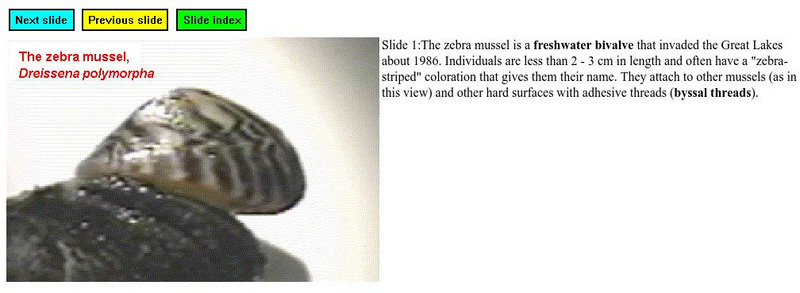Curated OER
Mucket Mania: The Mussel Industry in Arkansas
Middle and high schoolers read and discuss articles about the mussel industry in Arkansas. They pay close attention to the history of pearling and button making industries on the Black and White Rivers of Arkansas. This impressive,...
Curated OER
The Effects of Water Quality on the Growth Rate of Freshwater Mussels
Students participate in a field and laboratory study to determine if local freshwater mussels are environmentally stressed.
Curated OER
Zebra Mussels
In this zebra mussels worksheet, 7th graders read an article about zebra mussel populations in United States' lakes and rivers. Students read about the negative effects and some positive results and then answer several questions about...
Curated OER
Zebra Mussel Population Simulation
Pupils are taught how to format and enter data into an Excel spreadsheet. They make a graph, and interpret graphed data. Students discuss the possible impacts of zebra mussels on the Hudson river. They graph zebra mussel data.
Curated OER
Mussel Anatomy Lesson Plan
Students identify the parts and functions of a mussel. They explain how its physical adaptations help it survive in its habitat. They label the parts as a quiz to complete the lesson.
Curated OER
Great Lakes Ecology
Eighth graders identify the Great Lakes, and describe the habitat of life of a loon. They are able to point to and explain one of the major river systems that enters the Great Lakes with a focus on the Clinton River and the food webs...
Curated OER
Mouthwatering Mollusks
Students investigate various forms of aquatic life. They use four senses, touch, taste, smell, and observation to explore mollusks. Students cook and taste various types mollusks, such as mussels, scallops, and squid.
Curated OER
Salt of the Earth: A Caddo Industry in Arkansas
Middle schoolers explore the history of the Caddo Salt Industry found in Arkansas. Along with learning about how salt deposits formed in Arkansas, learners study the process of salt production and how valuable salt is as a natural...
Biology Junction
Dissection of the Clam
Is the structure of a clam really as simple as it seems? Young scholars explore the anatomy of the clam in an engaging lesson presentation. The lesson highlights the digestive process of the clam as well as how it moves and what it does...
Biology Junction
Mollusks
Mollusks created every shell on Earth. Young scientists learn more about the phyllum mollusca in an informative presentation. It covers their characteristics, body plans, and relationships in the ecosystem. Then, it details each class of...
Curated OER
Facts on Fish Species
Here is a brief outline of facts on various Chesapeake Bay fish species. Use it as an example of what kind of information you want your life science learners to collect when you assign them a specific species to research. Another way to...
Curated OER
Seashell Homes
Pupils listen to a story about seashells. They discuss shelled animals. Learners describe the function of seashell. Pupils relate the function of a seashell to their own dwelling. They differentiate between shelled animals that make...
Curated OER
Great Lakes Ecology
Students are able to use a secchi disk to measure the turbidity of water by determining the depth at which the sechi disk is no longer visible and using the data in a formula to quantify the results. They are able to use Vernier probes...
Curated OER
BIOASSESSMENT OF STREAMS
Young scholars work as a team to gather organisms from a stream to evaluate if the water quality is excellent, good, or fair to poor.
Curated OER
Relating Number of Insect Species to Water Quality
Students are asked to respond to questions such as:" Have there been surveys of the area to inventory the species?" (For example, for a wetland area, do they know what amphibians live there and how abundant they are?) Are there any...
Curated OER
Black Pearls
Students examine where pearls come from and where mollusks are found. They discover how pearls are formed in nature and how they are they made by humans. They use ordinary oyster shells to examine mother of pearl.
PBS
Pbs Learning Media: Why We Should Protect Freshwater Mussels
In this interactive lesson, students will increase their understanding of the important role that freshwater mussels play in our watershed. Students will learn about freshwater mussel species, how mussels improve water quality in rivers...
US Fish and Wildlife Service
Discover Freshwater Mussels: America's Hidden Treasure
This resource explains the critical role that mussels play in the United States.
Other
Zebra Mussel Page: Zebra Mussel Slide Show
Click through the whole slide show to find basic information on zebra mussels, how they live, the problems they can cause, and possible solutions.
University of Massachusetts
University of Mass.: Freshwater Mussel Reproduction
This site, which is provided for by the University of Massachusets, gives a very good example of a typical bivalve reproductive cycle.
Read Works
Read Works: Passages: "Zebra Mussels and the Hudson River"
[Free Registration/Login Required] The information passage "Zebra Mussels and the Hudson River" focuses on the Hudson River ecosystem and how the introduction of Zebra Mussels would impact it. A Step Read, an easier version of the...
Tennessee History For Kids
Tennessee History for Kids: Tennessee River Freshwater Pearl Farm
When people talk about Tennessee products, they usually talk about crops like soybeans, minerals such as limestone, and man-made things such as cars. During this tour, we'll talk about something produced in the Volunteer State that many...
Other
Marietta College: Mollusk Reproduction
Marietta College offers a detailed article on the reproduction cycle of freshwater mollusks.
Environmental Education for Kids
Eek!: Lake Superior
This site provides facts, illustrations, and more about the largest Great Lake. Includes descriptions of wildlife and industry. For grades 4-8.



















